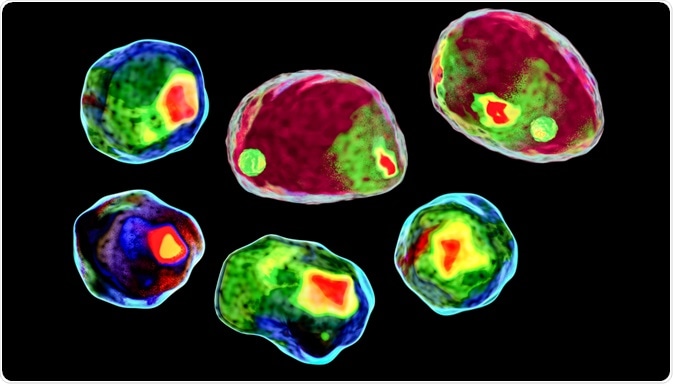Many tools provide useful information about biological systems that biologists have at their disposal. One particularly useful method which has aided many fields is flow cytometry. This article will provide a brief overview of the technique and how it is used to count single cells within a population.

Image Credit: Kateryna Kon/Shutterstock.com
What is Flow Cytometry?
Flow cytometry is a robust analytical tool used to count cells in a solution. It provides a multi-parametric analysis of single cells (or particles) as they move past a laser, producing both scattered and fluorescent light signals that are then analyzed by sophisticated software. The characteristics of these signals are used to deduce the physical and chemical characteristics of both cells and particles as well as providing quantitative data. Flow cytometry is a high-throughput technique.
A flow cytometer typically consists of an injector and sample tube, laser (this can be either a single laser or multiple lasers), an optical detector, and the software necessary to analyze the data produced. Ideally, the sample is focused so that cells pass the laser one at a time. Fluorescent markers are introduced into the cells, which produce unique spectra providing characteristic information about cellular processes.
Visible light scatters produced by the laser provide information on the relative size of the cell (forward scatter) and the internal complexity of the cell (side scatter.) This light scatter is independent of fluorescence. Samples are prepared for fluorescence analysis by staining with fluorescent dyes or fluorescently conjugated antibodies. Quantum dots can also be used.
Flow cytometry has found applications in disciplines such as immunology, molecular biology, virology, and infectious disease monitoring. Aside from analyzing cell populations, flow cytometry is used to sort cells for further analysis. It is an extremely important technology and has become one of the benchmarks of analytical biology.
Uses of Flow Cytometer
Flow cytometry has been used in clinical trials, clinical practice, and research. Uses include:
- Biomarker detection
- Cell sorting
- Cell counting
- Protein engineering detection
- Diagnosis of disease
- Determining cell function and characteristics
- Detection of microorganisms.
Counting Single Cells with Flow Cytometry
As mentioned, flow cytometry is used to characterize cells within a population. However, just passing the cells (or particles) through the flow cytometer is not enough to sort and analyze single cells. Cells must pass the laser uniformly to accurately measure their properties.
One main problem with achieving this is that the flow cell must be thin enough to hold a single cell. Normal manufacturing processes are not enough to create a flow cell of this size, as it would need to have a width of only a few micrometers, with a length of several millimeters. Most standard flow cells have a size of 250 x 250 micrometers, which is not small enough.
To solve this issue, a lot of work has been done and new techniques have been developed to better focus the sample in the flow cell to make single-cell analysis possible. They include:
- Hydrodynamic Focusing – This commonly-used technique uses the principles of fluid dynamics to sort cell populations into single cells for analysis by a flow cytometer. A sheath of liquid is built up in wide flow cells, and the sample is injected into the center. If the two liquids differ enough in density or velocity, a stable two-layer flow is achieved.
- Acoustic-assisted hydrodynamic focusing – Acoustic-assisted hydrodynamic focusing differs from hydrodynamic focusing as it uses radiation pressure. This is used instead of or as well as hydrodynamic focusing. This technique enables much higher volumetric input rates than are achievable through hydrodynamic focusing alone. Assay time is reduced, as well as modifying or eliminating concentration steps in sample preparation. Sub-microliter volumes can also be processed using sample dilution.
- Magnetic flow cytometry – Samples of cells can also be sorted using magnetic focusing. Labeled cells can be sorted and analyzed by this technique, even in relatively opaque media such as whole blood. This new technique shows potential for time-of-flight (TOF) magnetic sensing of cells in a variety of clinical settings, even at the bedside. Studies are ongoing into this emerging cytometric technique.
- Fluorescence flow cytometry – Fluorescence flow cytometry uses a semiconductor laser beam to separate fluorescently marked cells. Three different signals are used – forward scatter, side scatter, and side-fluorescent light. The front scatter provides information on cell size, the side scatter provides information on cell contents and structure, and the side fluorescence provides information on nucleic acids present. This technique is used to count bacteria, red blood cells, and white blood cells, as well as other elements. Fluorescence flow cytometry is used in analyzers for fields such as urinalysis and hematology.
In Conclusion
Flow cytometry is an incredibly robust high-throughput analytical technique. In recent years, the technique has been adapted to suit the needs of modern medicine, providing highly accurate information on the physical and chemical characteristics of individual cells within a population. New techniques are emerging all the time, and research in this field represents some of the most innovative thinking in medical science today.
References:
Further Reading
"flow" - Google News
August 23, 2021 at 08:22PM
https://ift.tt/3keDXEZ
Counting Single Cells Using Flow Cytometry - News-Medical.net
"flow" - Google News
https://ift.tt/2Sw6Z5O
https://ift.tt/2zNW3tO
Bagikan Berita Ini














0 Response to "Counting Single Cells Using Flow Cytometry - News-Medical.net"
Post a Comment